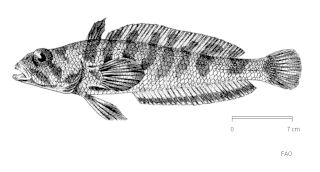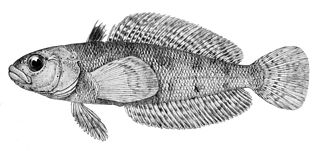
The Antarctic toothfish is a large, black or brown fish found in very cold (subzero) waters of the Southern Ocean near Antarctica. It is the largest fish in the Southern Ocean, feeding on shrimp and smaller fish, and preyed on by whales, orcas, and seals. It is caught for food and marketed as Chilean sea bass together with its sister species, the more northerly Patagonian toothfish. Often mistakenly called "Antarctic cod," the Antarctic toothfish belongs to the notothen family (Nototheniidae), a group of fish species abundant near Antarctica.

Notothenia microlepidota, the black cod or small-scaled cod, is a species of marine ray-finned fish, belonging to the family Nototheniidae, the notothens or cod icefishes. It is native to the Pacific waters around New Zealand and Macquarie Island. This species can reach a total length of 70 cm (28 in). It is a commercially important species.

Nototheniidae, the notothens or cod icefishes, is a family of ray-finned fishes, part of the suborder Notothenioidei which is traditionally placed within the order Perciformes. They are largely found in the Southern Ocean.

Notothenioidei is one of 19 suborders of the order Perciformes. The group is found mainly in Antarctic and Subantarctic waters, with some species ranging north to southern Australia and southern South America. Notothenioids constitute approximately 90% of the fish biomass in the continental shelf waters surrounding Antarctica.

The marbled rockcod is a species of marine ray-finned fish, belonging to the family Nototheniidae, the notothens or cod icefishes. It is native to the Southern Ocean, where it can be found at depths from 5 to 350 m. This is a commercially important species.
The bald notothen, also known as the bald rockcod, is a species of marine ray-finned fish belonging to the family Nototheniidae, the notothens or cod icefishes. It is native to the Southern Ocean.

Notothenia is a genus of marine ray-finned fishes belonging to the family Nototheniidae, the notothens or cod icefishes with the species in this genus often having the common name of rockcod. They are native to the Southern Ocean and other waters around Antarctica.

Paranotothenia magellanica, also known as Magellanic rockcod, Maori cod, blue notothenia or orange throat notothen, is a species of marine ray-finned fish, belonging to the family Nototheniidae, the notothens or cod icefishes. It is native to the Southern Ocean. "Maori chief" and "black cod", sometimes used for this species, usually refer to fishes from the related genus Notothenia. Being a perciform fish, it is unrelated to the true cods of the order Gadiformes. This species is commercially important as a food fish.

The blackfin icefish, also known as the Scotia Sea icefish, is a species of crocodile icefish belonging to the family Channichthyidae. The blackfin icefish belongs to Notothenioidei, a suborder of fishes that accounts for 90% of the fish fauna on the Antarctic continental shelf. Icefishes, also called white-blooded fishes, are a unique family in that they are the only known vertebrates to lack haemoglobin, making their blood oxygen carrying capacity just 10% that of other teleosts. Icefishes have translucent blood and creamy white gills.

The emerald rockcod, also known as the emerald notothen is a species of marine ray-finned fish belonging to the family Nototheniidae, the notothens or cod icefishes. It is native to the Southern Ocean where it is a commercially important species.

Trematomus is a genus of marine ray-finned fishes, belonging to the family Nototheniidae, the notothens or cod icefishes. These fishes occur in the Southern Ocean.

Gobionotothen is a genus of marine ray-finned fishes belonging to the family Nototheniidae, the notothens or cod icefishes. They are native to the Southern Ocean.

The grey rockcod, also known as the grey notothen, stripe-eyes notothen or stripe-eyed rockcod, is a species of marine ray-finned fish belonging to the family Nototheniidae, the notothens or cod icefishes. It is native to the Southern Ocean. The grey rockcod feeds mainly on macrozooplankton and is of minor importance to commercial fisheries. It is the only species in the genus Lepidonotothen.

Patagonotothen is a genus of marine ray-finned fishes, belonging to the family Nototheniidae, the notothens or cod icefishes. They are native to the southeast Pacific Ocean, southern Atlantic Ocean and the Southern Ocean.
Antarctic fish is a common name for a variety of fish that inhabit the Southern Ocean. There are relatively few families in this region, the most species-rich being the Liparidae (snailfishes), followed by Nototheniidae. The latter is one of eight different families that belong to the suborder Notothenioidei of the order Perciformes. They are also called notothenioids, but this name is also used to describe the other three, non-Antarctic families and some of the non-Antarctic genera in the mainly Antarctic families belonging to the suborder.
Notothenia neglecta, the yellowbelly rockcod, is a species of marine ray-finned fish, belonging to the family Nototheniidae, the notothens or cod icefishes. It is found in the Southern Ocean in Antarctica. They are omnivorous, and are found in both benthic and pelagic regions of the ocean. Their diet includes krill, bivalves, and gastropods. They have evolved unique behaviors and morphological features in order to thrive in the cold and harsh Antarctic climate. N. neglecta is also commercially fished, although not in high numbers.

Gobionotothen gibberifrons, the humped rockcod or the humphead notothen, is a species of marine ray-finned fish belonging to the family Nototheniidae, the notothens or cod icefishes. It is native to the islands of the Scotia Arc, the northern part of the Antarctic Peninsula, and Heard Island in the Southern Ocean. This species inhabits depths of 6-429 m, but is most abundant at depths of 100-400 m, at least around Elephant Island.

Notothenia cyanobrancha, the blue rockcod, bluegillnotothen, or bluegill rockcod, is a species of marine ray-finned fish, belonging to the family Nototheniidae, the notothens or cod icefishes. It is native to the Kerguelen and Heard Islands in the Southern Ocean.

Notothenia trigramma is a species of marine ray-finned fish, belonging to the family Nototheniidae, the notothens or cod icefishes. It occurs in the southwestern Atlantic Ocean.

The stocky rockcod, also known as the bandtail notothen, is a species of marine ray-finned fish belonging to the family Nototheniidae, the notothens or cod icefishes. It is found in the Southern Ocean.















